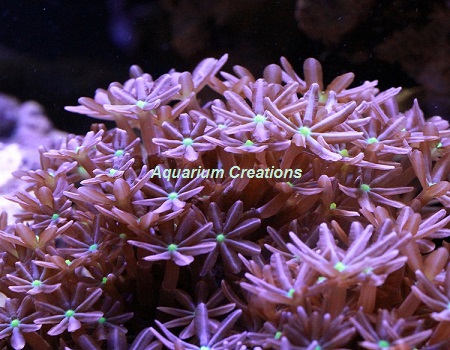Daisy Polyps, are also referred to as Jasmin Polyps, Starburst Polyps, or Eight Tentacle Polyps. The Daisy Polyp Corals are very easy to keep and they grow fairly quick. This is one coral that is VERY hardy and can recover from the most adverse condition. An excellent beginner coral. It's an excellent coral for the money because it grows quickly to create a lush coral reef by spreading over rock work. Like all of our polyps they are aquacultured specimens, many generations removed from the original wild starter colonies. Daisy Polyps were clssified along with many other types of polyps as Clavularia. In 2007 it was decided they were there own species. They have now been classified as Knopia octocontacanalis in 2007. They are related to Clove Polyps (Clavularia sp.), Star Polyps (Pachyclavularia sp.) and Waving Hand Polyps (Anthelia sp.). They have eight fan-like tentacles at the end of each polyp and grow from an encrusting base.
Accurately described as an encrusting coral, Starburst Polyps rapidly grow over adjacent rock work, coral, or even the glass of an established reef aquarium. They are easy to maintain in the reef aquarium and make an excellent candidate for the beginning through expert reef aquarist. They require a medium to high light level combined with a medium to strong water movement within the aquarium. For continued good health, they will also require the addition of iodine and other trace elements to the water.
Aggressiveness
They are a peaceful coral with the capability of being able to retract or deflate their polyps in response to a bothersome predator. They will not bother nearby corals since they do not have sweeper tentacles.
Waterflow
We recommend a moderate to high level of waterflow.
Lighting
Daisy Polyps require a low to moderate lighting level,(PAR 100-250), to maintain their color. T5's, Metal Halides, or LED's can all grow Daisy Polyps when the proper PAR levels are provided. We recommend a 14-20K color spectrum for best colouration of the coral.
Placement
Blue Sympodium Coral may be placed anywhere which provides the required waterflow and lighting level.
Diet and Feeding
In captivity, the symbiotic algae zooxanthellae hosted within their bodies provide the majority of their nutritional requirements through photosynthesis. We also recommend weekly feeding's of micro-plankton or other reef foods designed for filter feeding invertebrates. Good choices include Marine Snow, Artemia nauplii, and rotifer's. If your lighting is not as strong as desired, the feeding's will be more important since they will not be developing as much zooxanthellae on their own. Increase feeding's to twice a week in that case. To help provide food for all your corals we strongly suggest putting up a refugium for your reef system. Make sure it has at least a 4" sand bed. It really helps your coral do well since it naturally provides correct food for your corals.
|



